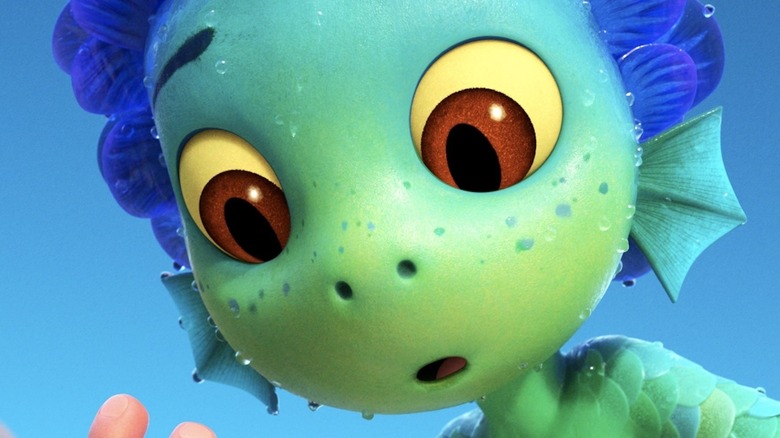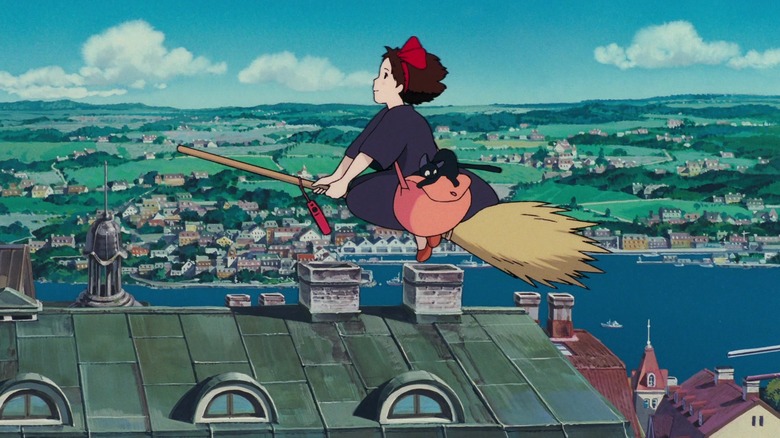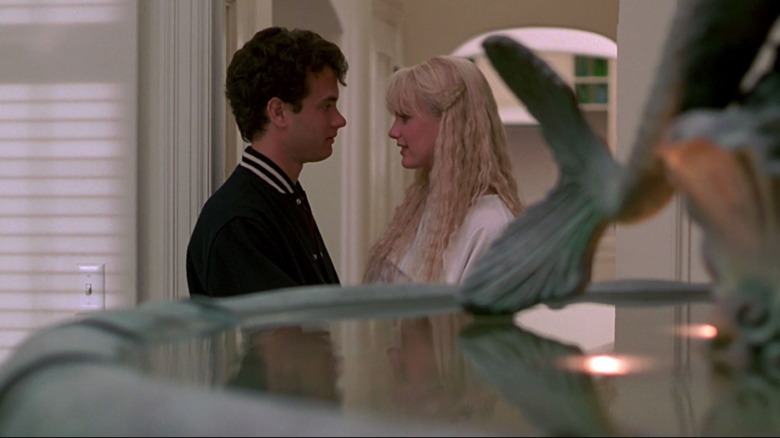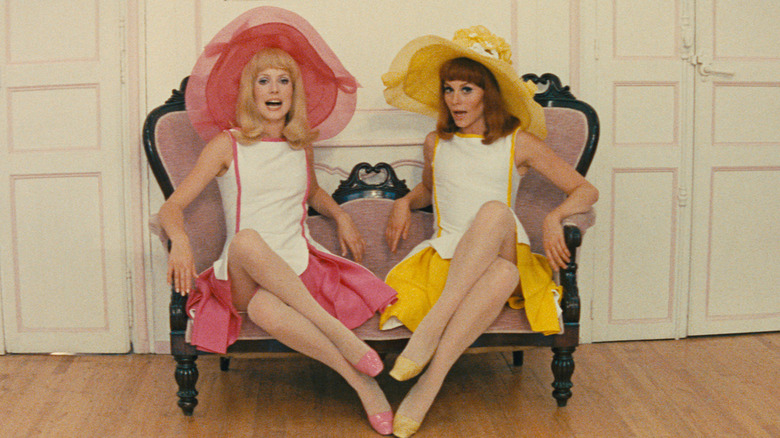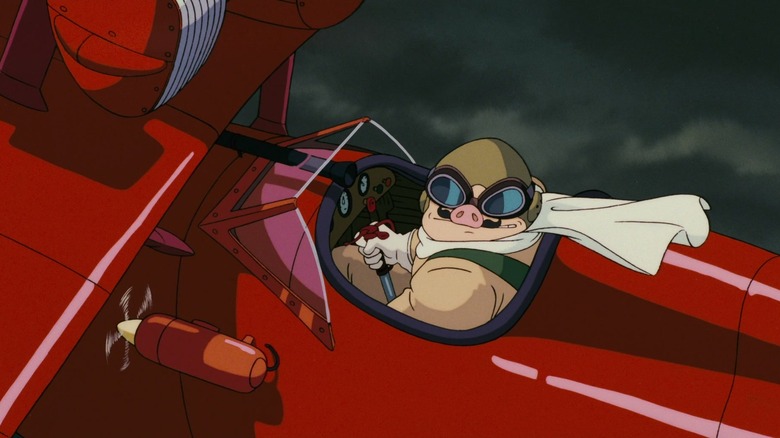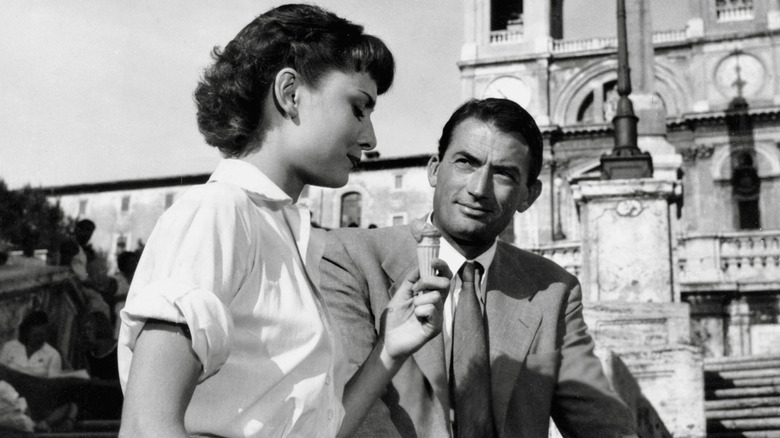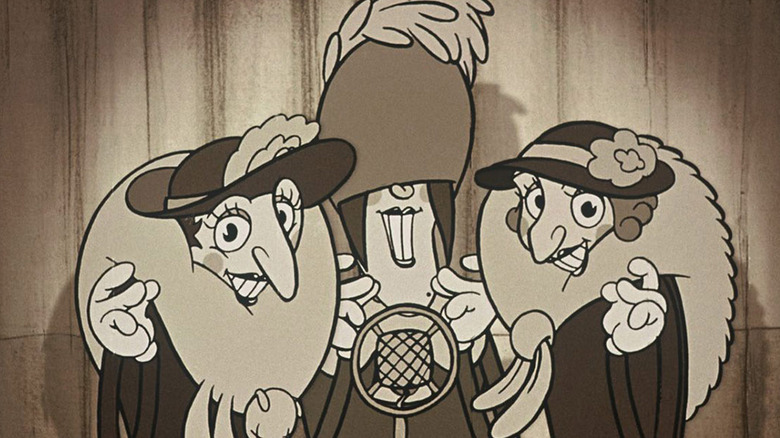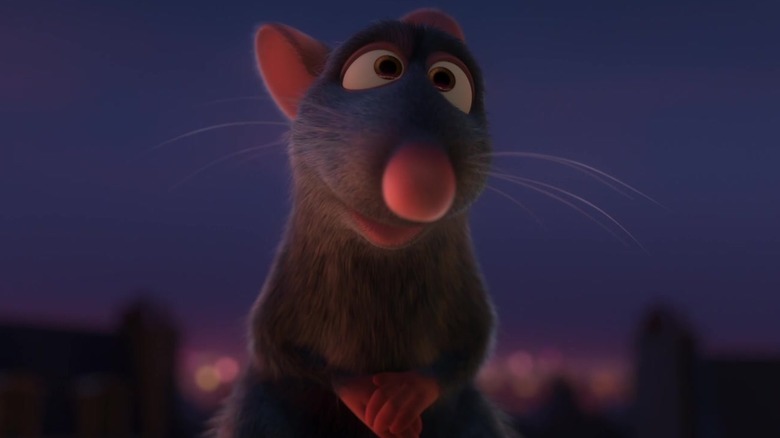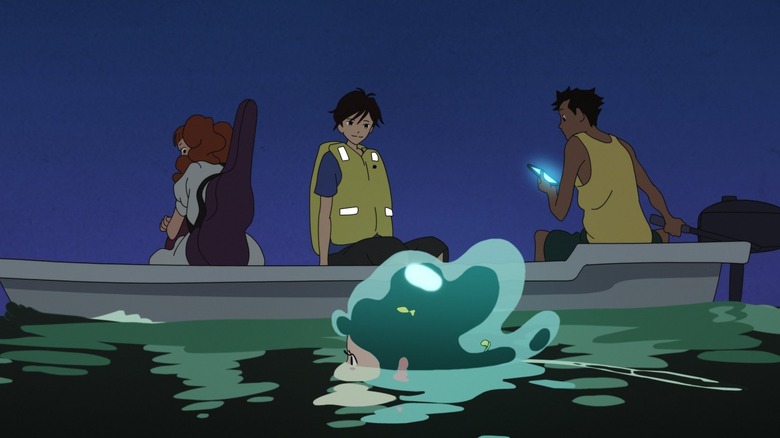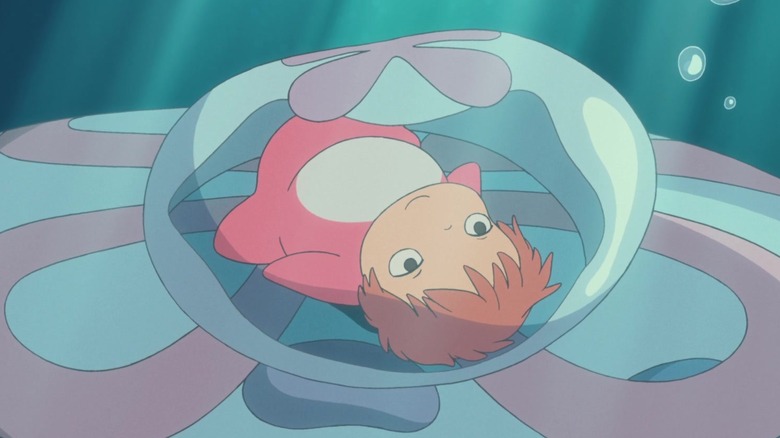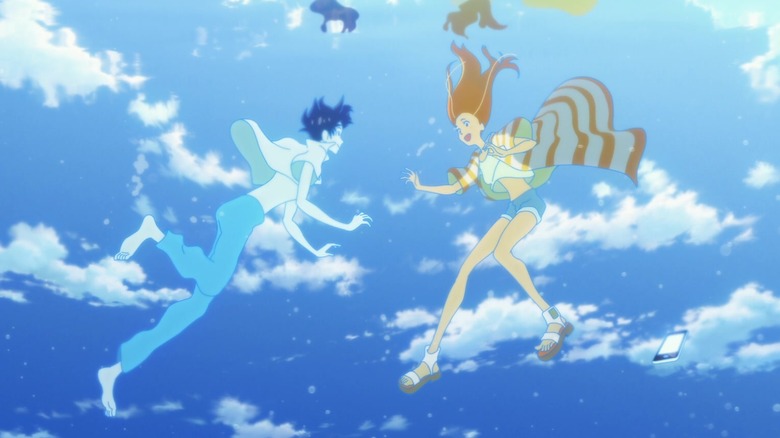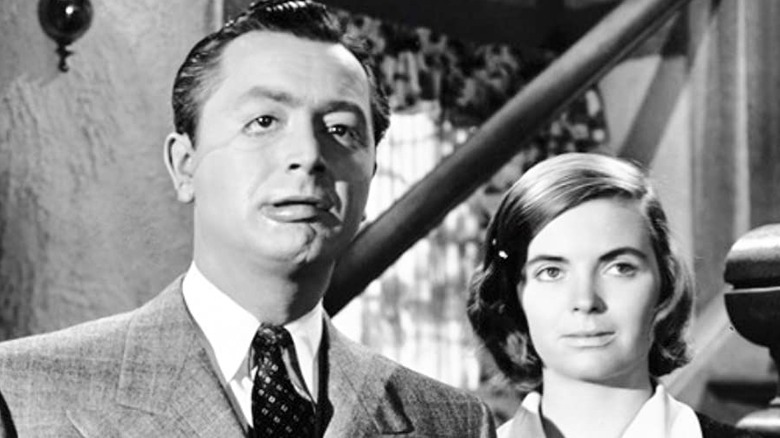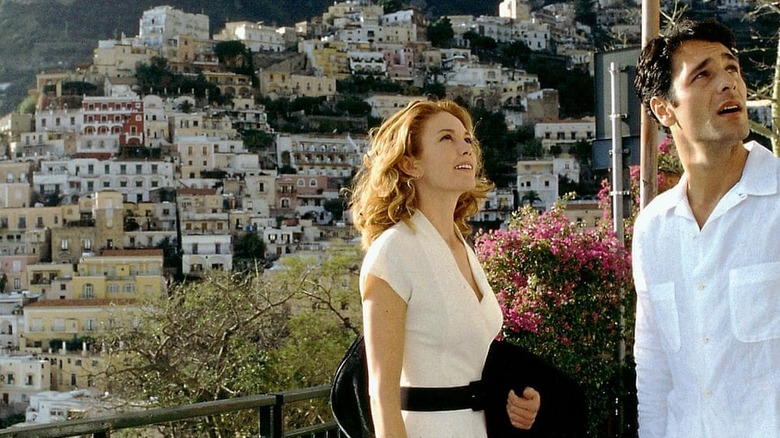Movies To Watch If You Loved Luca
Pixar's "Luca" is a majestic summer fantasy with seaside aesthetics and emotional core. In it, a young sea monster named Luca transforms into a human to explore the coastal Italian village Portorosso, where he bonds with another young monster named Alberto, leading to the adventure of a lifetime. After spending some time on land, Luca never wants to leave.
You may agree. Not only is "Luca" a heartwarming story about a bond between two friends, but its lush visuals, whimsical soundtrack, and idyllic depiction of the Italian seaside make it a film that, at 95 minutes, feels far too short.
Looking for a way to keep the comforting vibes of "Luca" going forever? Well, have no fear — there are plenty of movies out there that capture what makes "Luca" so special. From animated fairy tales to classic romantic comedies, you'll find a similar cozy quality (and some incredible-looking food) in the features listed below.
Kiki's Delivery Service
Adapted from Eiko Kadono's classic book, Hayao Miyazaki's coming-of-age story "Kiki's Delivery Service" brings a familiar tale of growing up to life, told through the eyes of a young witch. Like "Luca," it travels the bumpy road of adolescence while showcasing a whimsical European setting, enticing vintage designs, and delicious baked goods in almost every frame.
Aside from the obvious nods to Studio Ghibli found throughout "Luca," what really makes "Kiki's" such a great pairing with Pixar's film is that both movies are fascinated with modes of transportation. It's no secret that Miyazaki himself loves flight, and this is particularly evident in "Kiki's." Not only does the film feature its lead character riding on a broomstick, but Kiki's friend Tombo is obsessed with creating a flying machine. It's a fixation that's echoed in "Luca," with Luca and Alberto's desire to make and ride a Vespa.
"Kiki's Delivery Service" and "Luca" also share a simplicity when tackling more mature topics. And then, there's the comfort factor: like "Luca," "Kiki's Delivery Service" ultimately feels like Miyazaki is wrapping viewers in the most comforting blanket he has to offer.
Splash
If your favorite parts of "Luca" were the sea-monster elements, then the '80s nostalgic classic "Splash" should be right up your alley. Both films feature kids from different worlds who create lifelong bonds while venturing outside of their comfort zones. "Splash" might be cheesy, but it still holds up today thanks to its comedy sequences, its costumes, its soundtrack choices, and — of course — its mermaid aesthetics.
It's important to remember that "Splash" came out before Disney's other big undersea flick, "The Little Mermaid," and set the standard for how pop culture depicted mermaids for quite some time. Daryl Hannah's mermaid sparked a surge in babies named "Madison," and set the template for how innocent, wide-eyed fantasy characters interact with the human world, reminiscent of how Luca treats the people of Portorosso.
It may seem like the similarities between Luca and Madison end there, but the sea-dwelling protagonists of both "Splash" and "Luca" have to choose between their ocean homes and the human world they've begun to adore, giving the two movies a similar thematic resonance, too. The choices may seem obvious to the viewer, but it's a difficult decision for both Madison and Luca, giving their arcs some real, relatable stakes.
The Young Girls of Rochefort
Though it doesn't feature sea monsters or any magical transformations, Jacques Demy's underrated musical "The Young Girls of Rochefort" serves as a great aesthetic pairing with "Luca." Not only do both films feature stunning European locations that make you want to book a flight immediately, but they also contain catchy tunes, well-dressed characters, and shots packed with charming little details.
Two similarities in particular stand out. Both movies have bright and vibrant color palettes, and the movies' protagonists travel on parallel arcs. In "Young Girls," Gemini-twin sisters Delphine and Solange have ambitions they can't achieve while living in Rochefort. Thus, they plan on escaping to Paris, hoping that they can make their dreams a reality. Much like Alberto and Luca, the sisters also resort to unconventional methods to achieve their goals and face doubts along the way, making their journey much more difficult.
"The Young Girls of Rochefort" beautifully balances thrills with innocence, and while it might not have the sweeping intensity of Demy's "The Umbrellas of Cherbourg," which is another musical set amid a colorful European backdrop, it, like "Luca" revels in its naïveté. You don't always have to go big and bold. Sometimes, simple works out the best.
Porco Rosso
In the pantheon of Hayao Miyazaki's work, "Porco Rosso" is easily amongst his most mature creations — and given that the lead protagonist is a World War I pilot who looks like a pig, that's saying something. But "Luca" owes quite a bit to "Porco Rosso": First, there's the name of the town in "Luca," Portorosso, which is almost certainly a nod to Miyazaki's classic. The Italian Riviera is the setting for both films, and "Luca" director Enrico Casarosa directly admitted that his movie's aesthetic was directly inspired by Studio Ghibli. The connections seem pretty clear.
Yet, what makes "Porco Rosso" a great cinematic pairing with "Luca" is how both films utilize the charms of their locations. "Porco Rosso" captures the kitsch and grandeur of '20s Italy, while "Luca" evokes the colorful delights of the region's late '50s and early '60s era. Both movies feature flight, magical transformations, and much more; as companion pieces, you really can't do better.
Roman Holiday
When it comes to Hollywood features set in Italy, nothing quite beats the enchantment of "Roman Holiday." Sure, in contrast to the colorful landscapes of "Luca," modern viewers might find the black and white photography dated or boring. But, if you're willing to put your modern biases aside, the core of this William Wyler feature is utterly charming.
But how does the story of a princess and a reporter who embark on a romantic adventure connect to "Luca?" Besides the beautiful Italian locations — and both films' love of Vespas — the most significant common thread between the two is the wide-eyed enthusiasm of both Princess Ann (played by the iconic Audrey Hepburn) and Luca himself. Ann finds royal life dull and routine. Similarly, Luca wishes to escape his mundane undersea existence. When both protagonists get a chance to escape their usual boundaries, their whimsical reactions (and the lessons they learn along the way) lead to a joy that's infectious. As a member of the audience, you can't help but be swept up right along with them.
The Triplets of Belleville
Easily the most unconventional movie on this list, Sylvain Chomet's "The Triplets of Belleville" is the definition of quirky. This animated, almost dialogle-free, feature tells a story that involves '30s music hall entertainers, the French mafia, and the Tour de France, all from the perspective of a determined grandmother who is willing to do anything to protect her cyclist grandson.
So what does this odd little movie have to do with "Luca?" Well, if you're a big fan of international animated productions, "The Triplets of Belleville" checks every quirky, European-based box. With catchy tunes and unique visual presentation, it stands out from the more mainstream cartoons that Hollywood offers.
But the most unique element of "Triplets" is the special collection of characters that inhabit its hour-and-20-minute runtime. The adorable Madame Souza; the mustache-twirling mobsters; the titular singing sisters; like the characters in "Luca," Chomet's film is full of individuals who will live on in your noggin for years, in both delightful and possibly spooky sorts of ways.
Ratatouille
When it comes to the top-tier Pixar line-up, nothing is quite as classy as the Academy Award-winning "Ratatouille." Though its story centers on a rat, this tale of the metaphorical underdog attempting to triumph over impossible odds never loses its appeal. Much like "Luca," it spins a fantastical yet relatable tale — the kind of story that the people at Pixar have mastered.
Directed by animation legend Brad Bird, "Ratatouille" focuses on an unlikely hero, a rat named Remy. Similar to the struggle facing Luca (aside from the rat part), Remy wants to break away from the "norms" imposed by his culture. In both films, the two characters dream of impossible things that their families refuse to support. For Remy, his father discourages his dreams of becoming a chef. Likewise, Luca's mother refuses to embrace his interest in the human world.
This relatable conflict forges a bond between the audience and the protagonists of "Luca" and "Ratatouille," leading to powerful Pixar content. All of the studio's films have something that audiences connect with on a deeply human level, but Remy and Luca's stories are among the most significant for both their quality and their realism, despite the fantastical aspects they contain.
Lu Over The Wall
Masaaki Yuasa's "Lu Over The Wall" might seem like a visually overwhelming film on the surface, but underneath its colorful layers, this anime film has quite a bit in common with "Luca," especially when it comes to its mystical creature-focused plotline and the seaside town at the center of the story.
In the film, Kai Ashimoto is a middle schooler with some excellent musical skills. Unfortunately, his family isn't very supportive of his goals, and his band doesn't have a lead singer. One day, Kai meets a mermaid named Lu, who loves to sing. The two become friends, and — after Kai's musical abilities turn Lu into a human — Kai introduces Lu to the human world. However, the citizens of Kai's village don't like merfolk, stacking the deck against both Kai and his new companion.
Both "Luca" and "Lu Over the Wall" deal with familiar subject matter. The townspeople of Portorosso are similarly prejudiced against sea monsters, and the lead characters in both movies are wildly underestimated. Giulia hopes to win the Portorosso Cup race. Kai wants to become a songwriter. Watching both film's casts fight against the odds to achieve their dreams is thrilling.
Ponyo
In Hayao Miyazaki's "Ponyo," a goldfish (who happens to be the daughter of a wizard and the goddess of the ocean) becomes friends with a human boy, vowing to live by his side forever. But, as fantasy stories about friendship and magic tend to go, both lead characters must endure an emotion-filled adventure before they can find their happily ever after.
"Ponyo" might seem like the most obvious Ghibli movie to pair with "Luca" simply due to its transformation plotline and idyllic seaside setting. But even with those common elements pushed to the side, what makes "Ponyo" a fantastic movie counterpart to "Luca" is a straightforward concept: the emotional growth of the parent characters.
Both films' lead protagonists must endure emotional trials in order to convince their water-bound parents that their human adventures are positive choices. For Luca, he has to prove to his mother that the human world has benefits. Ponyo (aka Brunhilde) has to get both her parents and Sōsuke's mother to believe in the bond she and Sōsuke share. While both journeys have different destinations, the willingness of both characters to fight for what they believe in is a sight to behold.
Ride Your Wave
In Masaaki Yuasa's other ocean-filled film, "Ride Your Wave," two young lovers test the strength of their bond through an unbelievable set of circumstances. Though "Ride Your Wave" might come across as quite a fantastical tale, it is the down-to-earth nature of this romantic adventure that makes it such a treasure .
Much like "Luca," "Ride Your Wave" is a story about the lengths its characters will go to for various relationships. In "Wave," death and magic stand in the way of romance. 19-year-old surfer Hinako sees the ghost of her late boyfriend, Minato, in bodies of water whenever she sings their favorite song. Although Hinako is relieved that she can see Minato again, his spirit consistently pushes her to move on — something she refuses to do.
Though there are some plot parallels between "Ride Your Wave" and "Luca," the genuine emotions are what make the two films great to watch back-to-back. Just like the story of Alberto and Luca's bond, Hinako and Minato's relationship evokes warm, yet complicated, feelings.
The Enchanted Cottage
Much like "Roman Holiday," "The Enchanted Cottage" is a film that will work for those willing to give classic TCM fare a chance. This World War II-era film tells the story of a woman who is considered "homely" by the residents of her small town. She works at a local honeymoon-focused cottage, where she encounters a young, deformed veteran. Now living under the same roof, these two unlikely individuals find that a magical bond grows between them.
Like many of the films on this list, "The Enchanted Cottage" features characters who are magically transformed into more socially acceptable forms, and feel that those transformations improve their lives. Yet, like many stories of a similar nature, "The Enchanted Cottage" is really about acceptance. While Luca and Alberto's journey contains more action than Laura and Oliver's, all of these characters go through similar challenges, and learn some of the same lessons by the time the credits roll.
Modern film-goers might have a difficult time embracing the old-fashioned nature of "The Enchanted Cottage," but this story serves as both a heartwarming tale and also a tremendous jumping-off point for younger viewers who are curious about the world of classic cinema.
Under the Tuscan Sun
When it comes to early '00s romantic comedies, none of them get quite as cheesy as "Under the Tuscan Sun." Not only is it full of the genre's most ridiculous, specific tropes, but it stars the legendary Diane Lane, who delivers a performance that's frankly too good for such a simple movie.
So, what makes "Under The Tuscan Sun" a great film to watch after viewing "Luca?" Simply put, all the cozy, elegant Italian aesthetics. If you wanted more mouth-watering images of pasta like the ones served in Giulia's home, then "Under the Tuscan Sun" has got you covered. Are you on the hunt for idyllic Italian homes and furniture? "Tuscan Sun" has plenty.
But the most pleasing connection from "Luca" to "Under The Tuscan Sun" is the silly yet lovable nature of all the characters. Some of them might be cartoonish depictions of Italians, but like the cast of "Luca," all of them have a sweet and relatable appeal, making it easy to transition from one film to the other.
